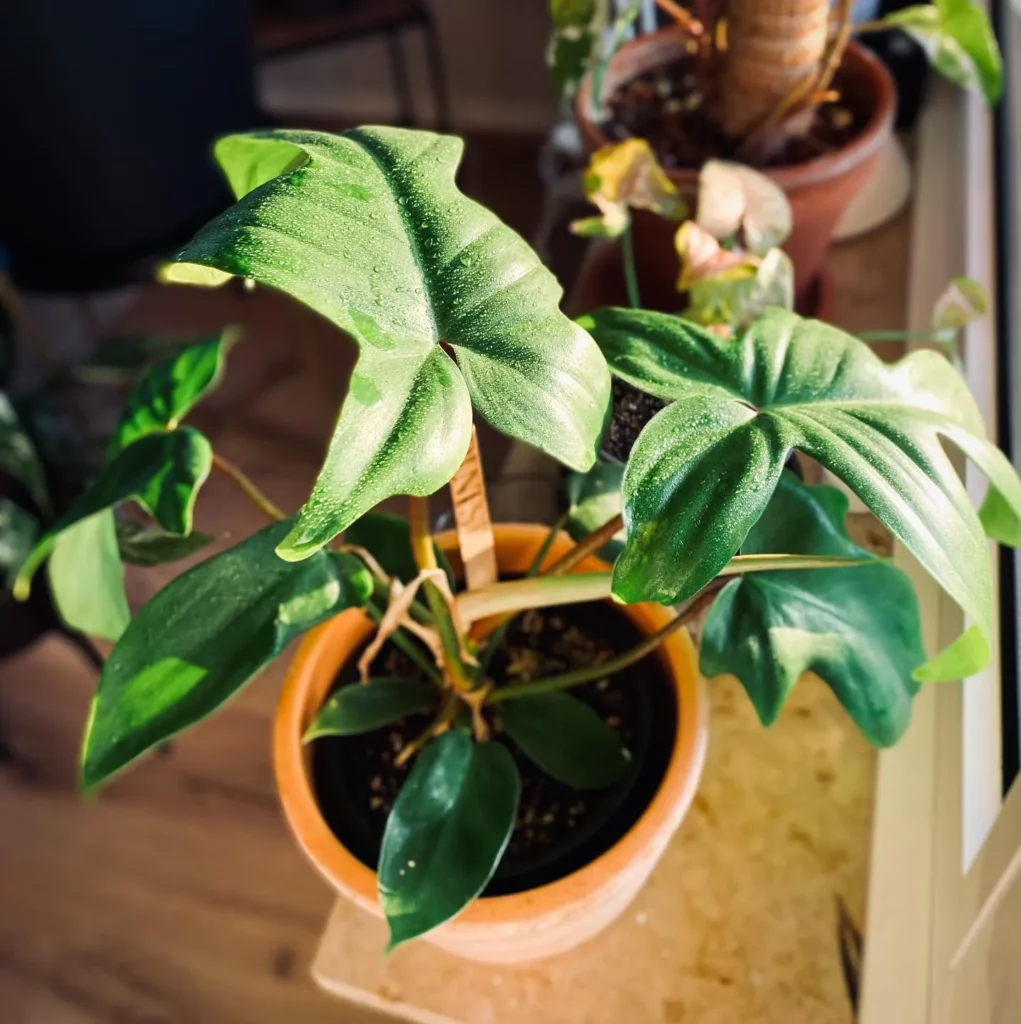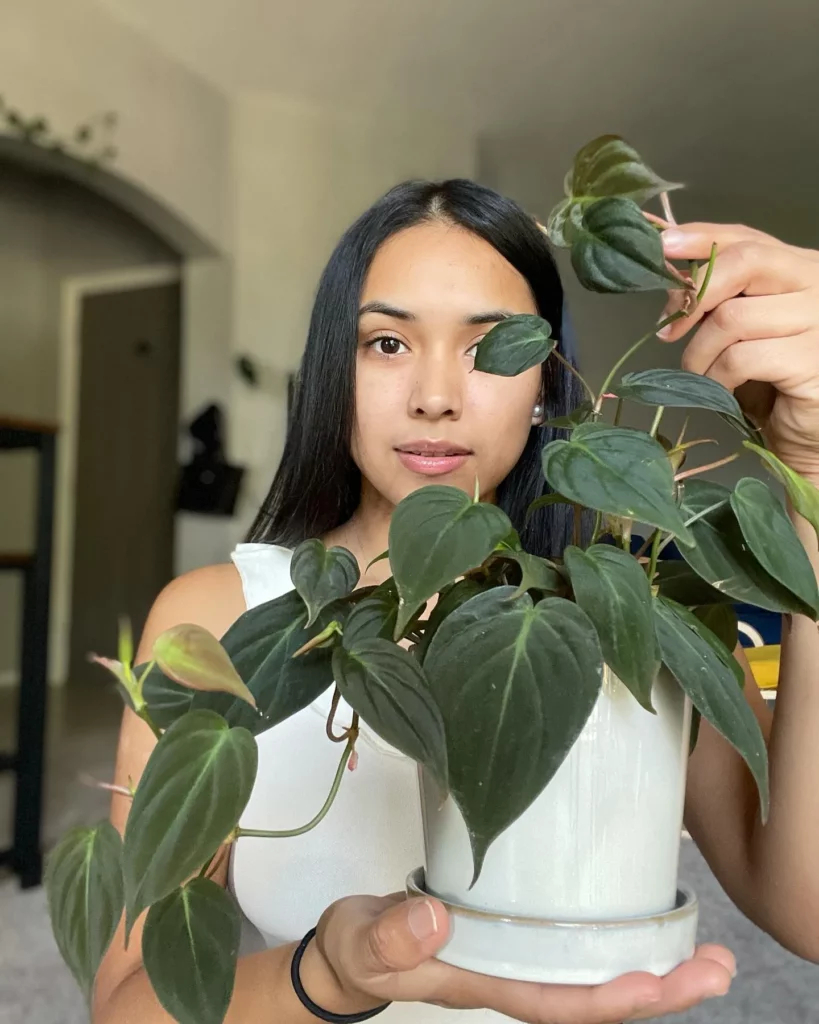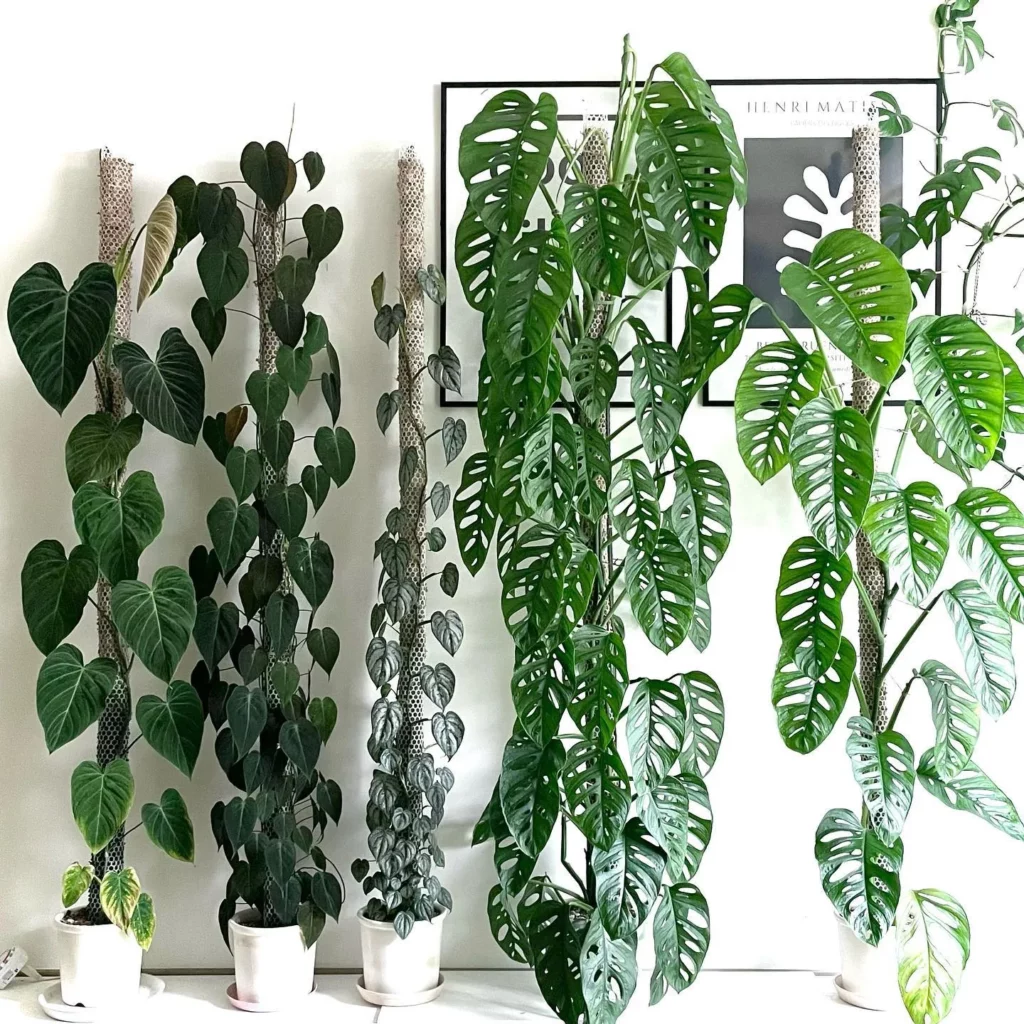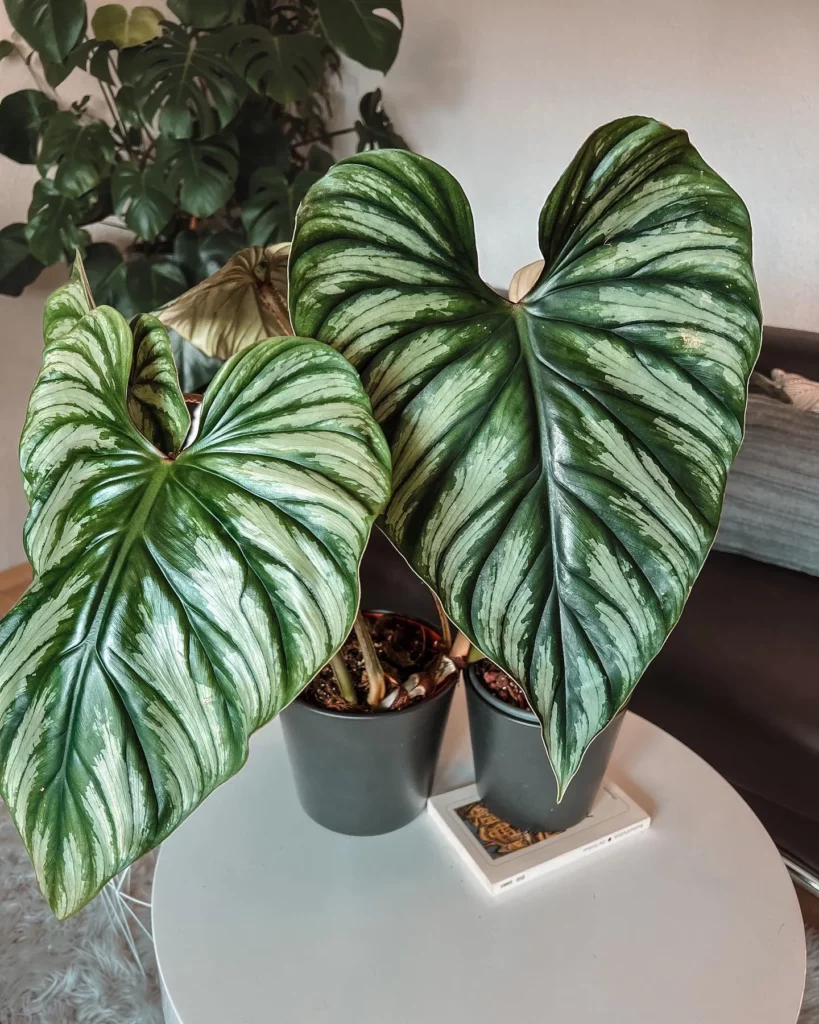Philodendrons are native to tropical regions of Central and South America and thrive in temperatures between 60°F to 90°F.
Different Philodendron species have different temperature tolerances, and colder temperatures below 50°F can cause damage to even the hardiest philodendrons. Keep reading and I’ll break it all down for you to know how to care for your Philodendron best!
Further Reading You’ll Like: Philodendron Pink Princess & Philodendron Ring of Fire
Perfect Temperature for Philodendron

In their natural habitat, philodendrons thrive in temperatures between 60°F to 90°F. These temperature ranges provide the ideal conditions for their growth and development.
Temperature is not the only factor to consider when caring for philodendrons or any other plant. Other factors such as humidity, light exposure, and soil moisture also play significant roles in their overall growth and health.
Humidity levels, for instance, can impact a plant’s ability to tolerate temperature fluctuations. High humidity levels generally enhance a plant’s ability to handle cooler temperatures, while lower humidity levels can cause drying out and leaf damage.
The Basics of Cold Tolerance



In order to understand how plants tolerate cold temperatures, it’s important to define what cold tolerance actually means. Cold tolerance refers to a plant’s ability to withstand cold temperatures without sustaining damage or dying. When temperatures drop, the water inside plants can freeze, leading to the rupture of plant cells due to ice expansion. This can result in irreversible damage and even death for sensitive plants.
| Factor | Influence on Cold Tolerance |
|---|---|
| Genetics | Determines the natural cold tolerance range of a plant species |
| Acclimation | Plants can acclimate to colder temperatures gradually over time, increasing their cold tolerance |
| Age | Younger plants may have less mature tissues that are more susceptible to damage from cold temperatures |
| Health | Healthy plants are generally more resilient and have better cold tolerance compared to stressed or diseased plants |
Philodendron’s Natural Habitat



Philodendrons are native to the tropical regions of Central and South America, where they can be found in a variety of habitats, including rainforests, swamps, and riverbanks. These plants have adapted to thrive in diverse environments and are known for their resilience and adaptability.
In their natural habitat, philodendrons often grow as epiphytes or hemiepiphytes, attaching themselves to trees or other support structures. This unique growth habit allows them to take advantage of available light and resources in the dense rainforest environment.
Their natural habitat provides the ideal conditions for philodendrons to flourish. They thrive in temperatures ranging from 60°F to 90°F, which is typical of tropical regions. This temperature range ensures optimal growth and development for these plants.
Cold Tolerance Range for Philodendron
While most philodendrons can tolerate temperatures as low as 50°F without experiencing damage, sudden drops or prolonged exposure to colder temperatures can harm even the hardiest philodendrons.
Different species of philodendron have varying levels of cold tolerance.
Some species like Philodendron bipinnatifidum and Philodendron selloum are more tolerant of cooler temperatures and can handle short periods below 50°F.
Other species like Philodendron erubescens and Philodendron gloriosum require much warmer environments and may suffer damage at temperatures below 60°F.
Cold Tolerance Range for Different Philodendron Species
| Philodendron Species | Cold Tolerance Range |
|---|---|
| Philodendron bipinnatifidum | Below 50°F, short periods tolerated |
| Philodendron selloum | Below 50°F, short periods tolerated |
| Philodendron erubescens | Above 60°F, sensitive to colder temperatures |
| Philodendron gloriosum | Above 60°F, sensitive to colder temperatures |
Factors Affecting Philodendron’s Cold Tolerance



Philodendrons’ ability to tolerate cold temperatures is influenced by several external factors, including humidity, soil moisture, and light exposure. These factors play a significant role in how well philodendrons fare in cooler environments.
High humidity levels enhance a philodendron’s cold tolerance. Adequate humidity helps prevent drying out and leaf damage, enabling the plant to withstand lower temperatures. On the other hand, lower humidity levels can negatively impact a philodendron’s ability to handle cold weather.
The moisture content in the soil is crucial for the overall health and cold tolerance of philodendrons. Proper soil moisture promotes root development and enables the plant to withstand colder temperatures more effectively. Overwatering or underwatering can lead to issues like root rot or stunted growth, which compromises a plant’s cold tolerance.
Light exposure also plays a role in a philodendron’s ability to tolerate cooler temperatures. Philodendrons that receive bright, indirect sunlight generally exhibit better resilience to cold weather compared to those kept in dimly lit areas.
The Truth About Humidity and Philodendron’s Cold Tolerance
Philodendrons are tropical plants that naturally thrive in warm and humid environments. When exposed to colder temperatures, their ability to tolerate the cold is heavily influenced by humidity levels. Low humidity can cause philodendrons to dry out, leading to leaf damage or even death. Maintaining proper humidity levels is essential for the survival and health of philodendrons. It is recommended to aim for a humidity level of at least 50% to ensure your philodendrons survive during colder periods.
Pro Tip: If your home is dry during the winter months, using a humidifier or placing a tray of water near your plants can help increase humidity levels. Not only will this benefit your philodendrons, but it will also improve the air quality in your home.
Soil Moisture: The Key to Philodendron’s Survival
The amount of moisture in the soil is crucial for the survival of philodendrons. Proper soil moisture is essential for root development and overall plant health. It is important to find the right balance to ensure the well-being of your philodendron.
Overwatering and underwatering can both be detrimental to philodendrons. Overwatering can lead to root rot and fungal infections, while underwatering can cause wilting and stunted growth.
Further reading: Watering Philodendron

A proper balance of soil moisture is essential for the survival of philodendrons.
Where to Place Philodendrons in Winter
During the winter months, it’s important to find a warm and sheltered spot indoors for your philodendrons. This area should receive bright, indirect light and have proper ventilation. Avoid placing the plants near drafts from windows or air conditioning, as they can be sensitive to extreme temperatures.
Kitchens and bathrooms are ideal locations, as they usually offer the correct climate for philodendrons. Proper humidity and air circulation should be maintained to ensure the well-being of the plants. LED grow lights can also be used to supplement light exposure if needed.
Proper Placement for Winter Survival
Avoid exposing your philodendrons to direct sunlight during the winter months, as this can lead to leaf burn. Instead, place them in a bright area with indirect light, such as near a north-facing window. This will provide them with the necessary brightness without subjecting them to direct sunlight.
Make sure the room has proper ventilation to prevent stale air and stagnant humidity. Good air circulation will help prevent the buildup of moisture, reducing the risk of fungal diseases.
When to Bring Philodendron Inside



Knowing when to bring your philodendron inside is crucial to protect it from colder temperatures. As a general guideline, consider bringing your philodendron indoors when temperatures drop below 55°F. While some species may tolerate slightly colder temperatures, prolonged exposure to cooler temperatures can still cause damage. It’s better to err on the side of caution and provide the necessary protection for your plants.
Before bringing your philodendron inside, there are a few steps you should take:
- Reduce watering frequency: As the weather gets cooler, your philodendron’s watering needs decrease. Only water it when the top two inches of soil are dry to avoid overwatering and root rot.
- Inspect for pests or decaying parts: Check your philodendron carefully for any signs of pests or decaying leaves. Removing these unhealthy parts will help prevent the spread of disease and ensure the plant’s overall health.
- Prune unhealthy parts: If you notice any long, leggy stems or yellowing foliage, consider pruning them off. This will help maintain the plant’s shape and encourage new growth.
- Choose a warm, dry location: Find a place indoors that provides a warm and dry environment for your philodendron. Proper ventilation is important to prevent the buildup of moisture, which can lead to fungal diseases.
- Ensure bright yet indirect light: Position your philodendron in a spot that receives bright, indirect light. Direct sunlight can be too intense and lead to leaf burns.
Cold Weather Care Checklist for Philodendrons

| Step | Description |
|---|---|
| Reduce watering frequency | Water only when the top two inches of soil are dry to avoid overwatering. |
| Prune unhealthy parts | Remove any long, leggy stems or yellowing foliage to maintain plant health. |
| Avoid drafts | Keep the plant away from drafts from windows, doors, air ducts, radiators, window panes, and cold floors. |
| Find a warm, dry location | Place the philodendron in a warm spot with proper ventilation and bright, indirect light. |
| Stop fertilizing | Pause fertilization during the colder months and resume in the spring when the plant begins actively growing. |
| Supplement light with LED grow lights | Use LED grow lights to provide additional light if needed, especially in areas with limited natural light. |
| Maintain proper humidity and soil moisture | Monitor soil moisture and maintain a humidity level between 50-60% to ensure the plant’s hydration. |
Cold Tolerance: Philodendron vs. Other Plants
While these tropical plants can withstand temperatures as low as 50°F, prolonged exposure to colder temperatures or sudden drops can cause damage.
In contrast, plants adapted to hotter and drier climates generally have lower cold tolerance and cannot handle the same range of temperatures as Philodendrons. On the other hand, evergreen plants are more resilient in colder climates and can tolerate sub-zero temperatures.
Considering these differences is crucial when selecting and caring for plants in colder regions. Understanding the specific cold tolerance ranges and limits of different plants will help ensure their survival and well-being.
Take a look at the comparison table below to get a better understanding of how Philodendrons’ cold tolerance compares to other plants:
| Plant | Cold Tolerance | Temperature Range |
|---|---|---|
| Philodendron | Tolerates temperatures as low as 50°F | 60°F to 90°F (preferred range) |
| Succulents | Low cold tolerance | Varies by species, generally prefers warmer temperatures |
| Evergreens | High cold tolerance | Can tolerate sub-zero temperatures |
| Desert Plants | Low cold tolerance | Thrives in hot, arid climates |
Conclusion
It is also important to consider other factors such as humidity levels, soil moisture, and light exposure when caring for philodendrons in colder climates. High humidity levels help philodendrons handle cooler temperatures, while proper soil moisture is essential for root development and overall plant health. Bright yet indirect light exposure is also beneficial for their growth.
By carefully considering these factors and providing the right conditions, philodendron owners can ensure the survival and thriving of their plants. Whether it’s adjusting temperature ranges, maintaining appropriate humidity levels, or monitoring soil moisture, paying attention to these details will help philodendrons withstand the challenges of winter and continue to flourish year-round.
FAQ
How cold can Philodendron tolerate?
Philodendrons can tolerate temperatures as low as 50°F, but prolonged exposure to colder temperatures or sudden drops in temperature can cause damage.
Why is temperature important for plants?
Temperature plays a crucial role in plant survival. Lower temperatures can affect water movement in plants, leading to wilting and even death.
What is cold tolerance?
Cold tolerance refers to a plant’s ability to withstand cold temperatures without sustaining damage or dying.
Where are Philodendrons naturally found?
Philodendrons are native to tropical regions of Central and South America, growing in habitats such as rainforests, swamps, and riverbanks.
What is the cold tolerance range for Philodendron?
Philodendrons can tolerate temperatures between 50°F to 90°F, with different species having varying levels of tolerance.
What factors affect Philodendron’s cold tolerance?
Factors such as humidity, soil moisture, and light exposure impact Philodendron’s ability to tolerate cold temperatures.
How does humidity affect Philodendron’s cold tolerance?
High humidity levels enhance Philodendron’s ability to handle colder temperatures, while low humidity can cause drying out and leaf damage.
Why is soil moisture important for Philodendron’s survival in cold weather?
Proper soil moisture is essential for Philodendron’s root development and overall plant health in colder temperatures.
Where should I place Philodendrons during winter?
During winter, place Philodendrons in a warm and sheltered spot indoors with bright indirect light and proper ventilation.
When should I bring Philodendron inside?
It’s recommended to bring Philodendrons inside when temperatures drop below 55°F to protect them from colder temperatures.
How should I care for Philodendron in cold weather?
To care for Philodendron in cold weather, reduce watering frequency, prune unhealthy parts, avoid drafts, and provide proper light and ventilation.
How does Philodendron’s cold tolerance compare to other plants?
Philodendrons have a moderate cold tolerance compared to other plants, but their specific cold tolerance ranges vary by species.





